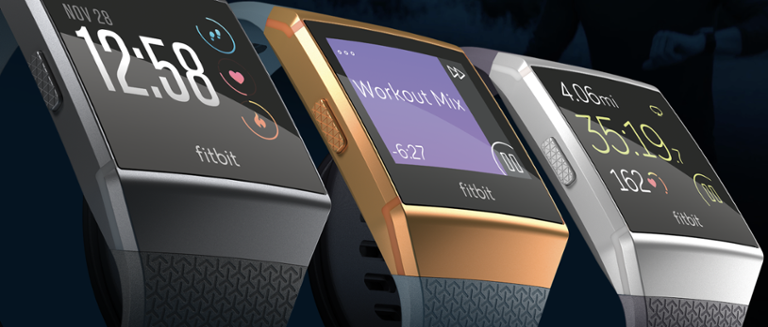
[caption id="attachment_143157" align="aligncenter" width="2386"]  Fitbit Ionic[/caption] With Fitbit’s Ionic smartwatch just days away from launch, the company is finally allowing developers to get their hands on the Fitbit OS SDK. At this point, the SDK uses a mix of JavaScript, CSS and SVG for apps and watch faces. That’s right, the Fitbit Ionic is essentially running web apps on a smartwatch. This seems to be how Fitbit OS, the company’s first proper operating system for its wearables, will stake its claim for developer’s attention. There are also some handy guides for how to use those various languages to make a successful Fitbit OS app. SVG is used for the ‘structure’ of an app, which handles much of the basic graphical user interface (GUI). CSS is in charge of on-screen text and other graphical elements, such as watch faces. JavaScript does the rest; it controls animations, event handling and how on-screen imagery interacts with Ionic's physical buttons. A logical assumption is that clock faces will figure prominently in Fitbit’s future. Right now, we can’t tell if the company has overlooked this aspect, or if faces are simpler than imagined for Fitbit OS: Fitbit’s developer site shows analog faces taking a mere seven lines of code, while a digital clock needs 17 lines of code. Sensors are critical, as well, and the Fitbit OS guidelines seem to be the same as with Fitbit's legacy bands. The Ionic has an accelerometer, barometer, gyroscope, heart rate and orientation APIs for developers. The Fitbit developer website says that “anyone with an Ionic smartwatch can start building apps and clock faces using the Fitbit SDK,” suggesting that developers first need to acquire an Ionic. There’s no dedicated simulator within Fitbit Studio, the company’s chosen IDE for developing Ionic apps. While we’re apt to forgive the shortcomings of a developer preview, Fitbit’s developer program seems fairly limited so far. There just isn’t a whole lot of Pebble baked in. After Fitbit acquired smartwatch-startup Pebble for $40 million in 2016, many of those developers who created for the Pebble ecosystem were encouraged to duplicate their efforts for Fitbit. But it doesn’t seem like Fitbit OS has the same developer synergy that Pebble did. Some early reviews of Fitbit's new smartwatch echo that fact. Those who have used the Ionic say it’s more fitness tracker than smartwatch, which won’t do it any favors when compared to Apple Watch. It’s also less stylish than most Android Wear devices, so the fitness-tracking ecosystem may be where Fitbit needs to make its home, smartwatch or no.
Fitbit Ionic[/caption] With Fitbit’s Ionic smartwatch just days away from launch, the company is finally allowing developers to get their hands on the Fitbit OS SDK. At this point, the SDK uses a mix of JavaScript, CSS and SVG for apps and watch faces. That’s right, the Fitbit Ionic is essentially running web apps on a smartwatch. This seems to be how Fitbit OS, the company’s first proper operating system for its wearables, will stake its claim for developer’s attention. There are also some handy guides for how to use those various languages to make a successful Fitbit OS app. SVG is used for the ‘structure’ of an app, which handles much of the basic graphical user interface (GUI). CSS is in charge of on-screen text and other graphical elements, such as watch faces. JavaScript does the rest; it controls animations, event handling and how on-screen imagery interacts with Ionic's physical buttons. A logical assumption is that clock faces will figure prominently in Fitbit’s future. Right now, we can’t tell if the company has overlooked this aspect, or if faces are simpler than imagined for Fitbit OS: Fitbit’s developer site shows analog faces taking a mere seven lines of code, while a digital clock needs 17 lines of code. Sensors are critical, as well, and the Fitbit OS guidelines seem to be the same as with Fitbit's legacy bands. The Ionic has an accelerometer, barometer, gyroscope, heart rate and orientation APIs for developers. The Fitbit developer website says that “anyone with an Ionic smartwatch can start building apps and clock faces using the Fitbit SDK,” suggesting that developers first need to acquire an Ionic. There’s no dedicated simulator within Fitbit Studio, the company’s chosen IDE for developing Ionic apps. While we’re apt to forgive the shortcomings of a developer preview, Fitbit’s developer program seems fairly limited so far. There just isn’t a whole lot of Pebble baked in. After Fitbit acquired smartwatch-startup Pebble for $40 million in 2016, many of those developers who created for the Pebble ecosystem were encouraged to duplicate their efforts for Fitbit. But it doesn’t seem like Fitbit OS has the same developer synergy that Pebble did. Some early reviews of Fitbit's new smartwatch echo that fact. Those who have used the Ionic say it’s more fitness tracker than smartwatch, which won’t do it any favors when compared to Apple Watch. It’s also less stylish than most Android Wear devices, so the fitness-tracking ecosystem may be where Fitbit needs to make its home, smartwatch or no.

